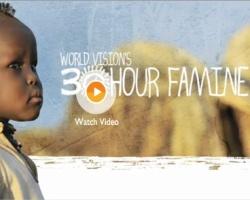New Study: Few Things More Important to Teens than Their Cell Phones
According to a new 30-Hour Famine study, conducted online in January by Harris Interactive, among more than 500 youth ages 13 to 17 years old, only 2 percent of American teens say they’d be willing to go without food for 24 hours. The survey commissioned by World Vision, an international relief and development group also revealed that less than one in 10 (9 percent) say they’d be willing to go 24 hours without their cell phone. The study found that four out of five teens (80 percent) use social media; almost half (44 percent) say they’ve become more aware of the needs of others as a result of their use of social media such as Facebook and Twitter; and about one in three (34 percent) “friend”, “like” or “follow” charitable organizations or causes in which they believe.
The average child spends an hour and a half texting each day.
More than four in five teens with cell phones sleep with the phone on or near the bed.
“While social media may be decried by some for the time teens today spend on it, the truth is it can help today’s youth learn more about important things in life. More than two in five teens say they have become more aware of the needs of others because of their use of Facebook or Twitter. One-third say they “friend,” “like” or “follow” charitable causes in which they believe, which helps spread the word within their circle of friends. This is teens using social media for social good,” says Regina Corso, senior vice president, Harris Poll Public Relations and Youth Research with Harris Interactive.
In February, hundreds of thousands of American teens wnet hungry in an effort to help Haiti earthquake survivors and fight global hunger through World Vision’s 30-Hour Famine. This year, more than 155 youth groups already have contacted World Vision about designating 30-Hour Famine funds to long-term Haiti recovery. Last year, $1.2 million went to Haiti Relief.
Michele Tvedt, World Vision’s 30-Hour Famine Manager says, “I’m really excited and grateful that teens here can have a direct impact on teens and children in Haiti.” Tvedt personally has done The Famine for 13 years, adding up to more than 390 hours through the years. Since 30-Hour Famine started in 1992, groups participating in Famine events have raised more than $140 million to fight global hunger.
During the February event, along with the April 29-30 event, hundreds of thousands of teens will participate in World Vision’s 20th Annual 30-Hour Famine, forsaking food for 30 hours to get a taste of what the world’s poorest children face. Prior to the event, teens raise funds by explaining that $1 can help feed and care for a child a day. So $1 for each hour they’ll fast, $30, can feed and care for a child for a month. As they fast, teens consume only water and juice as they participate in local community service projects (food banks, soup kitchens and homeless shelters). Part of the funds from this year’s 30-Hour Famine will go toward long-term relief in Haiti. Last year’s 30-Hour Famine raised $10.4 million with funds going to fight global hunger. This year’s fund-raising goal is $11 million.
Tonight, almost 1 billion people worldwide will go to bed hungry — that’s one out of every six people on earth — and 22,000 children die each day from hunger and preventable diseases. Chronic poverty, affecting half the people on earth, is the cause. Nearly 3 billion people live on less than $2 a day.
Where does 30-Hour Famine money go? Haiti, Ethiopia, Kenya, Somalia, Uganda, Sudan, South Sudan, Mauritania, Pakistan, Zambia, Zimbabwe and other targeted spots where famine, conflict and other crises make children vulnerable. Some 30-Hour Famine funds also are used to address poverty in the United States.
World Vision works in 100 countries, helping approximately 100 million people every year.




